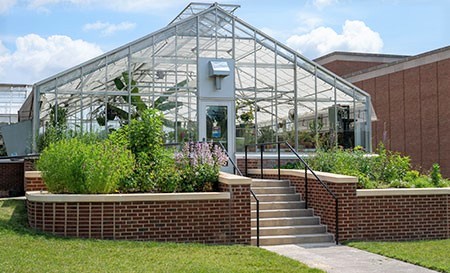
RADFORD – Dwarf pomegranates. A corpse plant. An Australian tree fern. A timid tarantula.
These are just a few examples of the lush vegetation and exotic critters blossoming in the Radford
University Greenhouse this summer.
According to greenhouse manager Stephanie Huckestein, there are between 200 and 300 different types
of plants growing in the greenhouse, which was remodeled in 2019 along with Reed and Curie halls and
is part of the biology department.
Huckestein, who spent 18 years at Virginia Tech in the School of Plant and Environmental Sciences,
maintains Radford’s greenhouse with an organic approach, using no harsh chemical sprays or fertilizers.
She admits it takes more work, but it’s worth it, she said.
“It is a labor of love,” she said as she plucked a few weeds from a nearby potted plant.
One of her favorite and most effective methods of removing pesky bugs is a simple yet powerful spray of
a water hose using a special nozzle.
The greenhouse, connected and adjacent to Reed Hall, consists of three different sections that boast a
variety of vegetation, from fruits to ferns to succulents to plants one might find in the Amazon rainforest.
A plant especially spectacular to student volunteer Luc White is a giant banana tree that sits in the front
section of the greenhouse. White, who uses the pronouns they, them and theirs, helped plant the tree about
a year ago.
“It reached to about here,” said White, pointing to their knee.
White gazed upward toward the same tree that is now almost touching the roof of the greenhouse.
“Pretty awesome, right?” they said.
White is one of many students who finds solace in the greenhouse, calling the facility an “inclusive and
welcoming space.”
“We have built our own little community here,” White said.
White, of Richlands, Virginia, is a first-generation student. They grew up on a farm and said the
greenhouse made them feel at home.
“It definitely helped make my transition to Radford an easier experience,” White said.
White is double majoring in studio art and biology with minors in French, women’s and gender studies
and chemistry, and concentrations in ecology and plants.
With White’s impressive course load and extensive knowledge of plants — thanks in part to their hands-
on experience in the greenhouse — they earned an internship at the Chicago Botanic Garden, a rare and
exciting opportunity.
Donya Mohamed is also volunteering at the greenhouse this summer, just like she did when she was a
student. From Blacksburg, Mohamed graduated from Radford University this spring. Her close proximity
to campus has allowed her to return often to help Huckestein and other volunteers.
“I used to come to the greenhouse a lot and just hang out after class. It’s a great place to meditate,” she
said.
This summer, Huckestein and volunteers are working to better organize the greenhouse. She envisions
different learning stations throughout, including a display of plants and insects that student-researchers
encounter on the Radford Amazonian Research Expedition (RARE).
As the fall semester approaches, she is also envisioning the facility as an “interdisciplinary teaching tool
and learning space.”
“There are so many different majors who could utilize this space,” she said. “From occupational therapy
to the arts, the greenhouse can be beneficial to so many of our students.”
The campus community is invited to visit the greenhouse and take a tour. To those passersby who are
unsure but curious of what’s inside:
“Just walk up. If the door’s unlocked, come on in,” White said.
Radford University’s Plant Club
Faculty, staff, students, plant lovers, and gardeners are welcome to talk plants, share plants, propagate
plants, and learn from each other.
Where: the Radford University Greenhouse
When: Every Monday from 4:15 to 5:15 p.m.
More information: Stephanie Huckestein, shuckestein@radford.edu
Mary Hardbarger
Radford University


